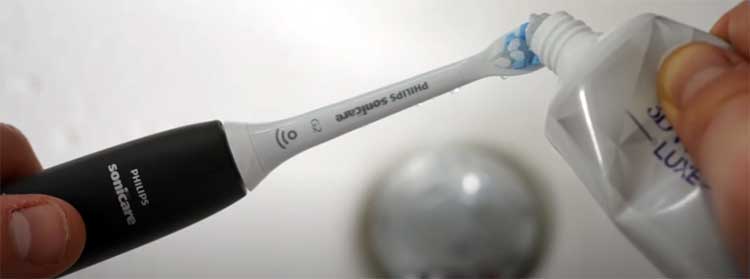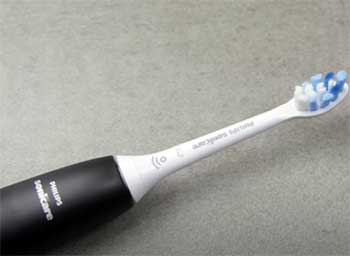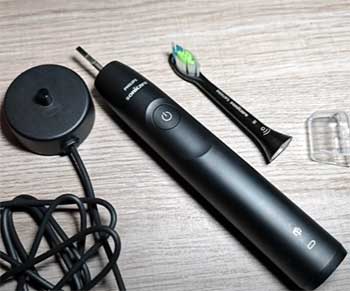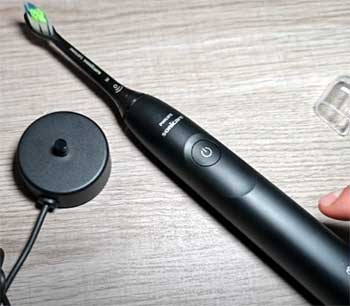I’ve been on a quest to find the perfect electric toothbrush, and after testing the Philips Sonicare ProtectiveClean 5100 and 5300, I’m ready to share my experience.
These two models promise sparkling clean teeth, but which one truly delivers for your needs? In this article, I’ll break down their features, weigh their pros and cons, and help you decide which brush suits your oral care routine.
Whether you’re after value, versatility, or just a great clean, I’ve got you covered with insights from real-world use.
A Brief Comparison Table
| Feature | Sonicare 5100 | Sonicare 5300 |
| Brushing Modes | 3 (Clean, White, Gum Care) | 3 (Clean, White, Gum Care) |
| Intensity Settings | 1 (Standard) | 2 (High, Low) |
| Brush Heads Included | 1 G2 Optimal Gum Care | 1 G2 Optimal Gum Care, 2 W2 Optimal White |
| BrushSync Technology | Yes (Replacement Reminder) | Yes (Replacement Reminder) |
| Pressure Sensor | Yes (Vibration Alert) | Yes (Vibration Alert) |
| Battery Life | Up to 14 days | Up to 14 days |
| Travel Case | Yes (Standard) | Yes (Standard) |
| Price (Approx.) | $79.97 | $109 |
| Colors Available | Black Gray, White Mint, White Light Blue | Black Gray |
This table sets the stage for what’s to come—a detailed look at how these brushes stack up in real-world use.
My Journey With Sonicare Toothbrushes
I’ve been using electric toothbrushes for years, but I hadn’t tried Philips Sonicare until recently. After hearing rave reviews about their sonic technology, I decided to test the ProtectiveClean 5100 and 5300.
Both are mid-range models, packed with features that promise to elevate your brushing game without the premium price tag of, say, the Sonicare DiamondClean. I used each brush for two weeks, twice daily, to get a feel for their performance, comfort, and quirks.
My goal?
To figure out which one offers the best bang for your buck and why.
First Impressions of Sonicare 5100 And 5300 Toothbrushes

Opening the Sonicare 5100 box, I found a sleek handle, a G2 Optimal Gum Care brush head, a standard travel case, and a charging base. The design is minimalist, with two buttons—one for power and one to toggle between the three modes: Clean, White, and Gum Care.
The 5300, on the other hand, felt like a slight upgrade right out of the gate. It came with three brush heads—one G2 Optimal Gum Care and two W2 Optimal White heads—along with the same travel case and charger.
The 5300 also offers two intensity settings, which I was eager to test.
Both brushes have a matte finish that feels premium in hand, though the 5300’s black-gray colorway looked sharper on my bathroom counter. The 5100’s color options (black gray, white mint, or white light blue) give you more variety, which is a nice touch if aesthetics matter to you.
I noticed the 5300’s power button felt softer to press, a small but welcome detail for someone like me who’s picky about ergonomics.
Core Features of Sonicare 5100 And 5300 Toothbrushes
Both the 5100 and 5300 boast Philips’ sonic technology, delivering up to 62,000 brush movements per minute.
This creates a dynamic cleaning action that pushes fluid between teeth and along the gumline, tackling plaque in places a manual brush can’t reach. In my tests, both left my teeth feeling polished and smooth, like I’d just left the dentist.
They also share a pressure sensor that vibrates the handle if you brush too hard, protecting your gums from overzealous scrubbing. The 2-minute timer with QuadPacer, which pulses every 30 seconds to remind you to switch quadrants, ensured I brushed evenly.
BrushSync technology, another shared feature, tracks brush head usage and beeps when it’s time for a replacement—typically every three months. Both models claim a 14-day battery life, and in my experience, they hit that mark with twice-daily use.
Sonicare 5100: A Closer Look

The 5100 is positioned as a budget-friendly yet feature-rich option in the ProtectiveClean lineup.
Its three brushing modes—Clean (standard daily brushing), White (for stain removal), and Gum Care (gentle on gums)—cater to a range of needs.
Each mode runs at a single intensity, which I found plenty powerful for everyday use.
The G2 Optimal Gum Care brush head is designed to clean along the gumline, and I noticed it was gentle yet effective, especially since I’ve dealt with sensitive gums in the past.
The travel case is a simple plastic clamshell, sturdy enough to protect the handle and two brush heads during trips. The charging base is compact, fitting neatly on my sink. At around $80, the 5100 feels like a solid deal for what you get, especially compared to pricier models like the 6100 or DiamondClean.
Pros of The Sonicare 5100
- Affordable price point, often around $80, making it accessible for most budgets.
- Three brushing modes offer versatility for daily cleaning, whitening, and gum care.
- Pressure sensor and QuadPacer ensure you’re brushing safely and thoroughly.
- Multiple color options let you pick a style that suits your vibe.
- Long battery life (14 days) is reliable for travel or busy schedules.
- BrushSync reminds you when to replace the brush head, taking the guesswork out.
Cons of The Sonicare 5100
- Only one intensity setting, which might feel too strong for sensitive teeth.
- Comes with just one brush head, so you’ll need to buy extras sooner.
- No LED indicators for modes, so you rely on feel to know which mode you’re in.
- Battery life, while good, started to wane slightly faster than the 5300 after weeks of use.
Sonicare 5300: A Step Up?

The 5300 feels like the 5100’s slightly fancier sibling.
It shares the same three brushing modes but adds two intensity settings—high and low.
This was a game-changer for me on days when my gums felt tender; the low setting was noticeably gentler while still effective.
The inclusion of three brush heads—two W2 Optimal White for whitening and one G2 Optimal Gum Care—gave me more options out of the box.
The W2 heads are designed to tackle surface stains, and after a week of coffee and tea, I did notice my teeth looked a shade brighter.
The 5300’s travel case and charger are identical to the 5100’s, but the extra brush heads and intensity settings justify its higher price of around $109. The ergonomic handle, with a slightly textured grip, felt secure even with wet hands, which I appreciated during rushed morning routines.
Pros of The Sonicare 5300
- Two intensity settings (high and low) allow for a customized brushing experience.
- Three brush heads included, saving you $20–$30 compared to buying them separately.
- Same powerful sonic technology as the 5100, with excellent plaque removal.
- Pressure sensor and QuadPacer promote safe and thorough brushing.
- BrushSync technology ensures timely brush head replacements.
- Sleek design with a comfortable, grippy handle enhances usability.
Cons of The Sonicare 5300
- Higher price point ($109) may not feel worth it for budget-conscious buyers.
- Limited to one color option (black gray), which might not appeal to everyone.
- No mode indicator lights, so you have to remember which mode you selected.
- Battery life is comparable to the 5100 but not noticeably better despite the price.
Performance of Sonicare 5100 And 5300 Toothbrush
After using both brushes for weeks, I can say they’re neck-and-neck in cleaning power. Both removed plaque effectively, leaving my teeth smooth and my breath fresh. I tested them with a plaque-disclosing tablet, and the results were nearly identical—minimal plaque remained after two minutes of brushing.
The sonic technology’s fluid action felt like a mini power wash for my mouth, reaching spots I’d miss with a manual brush.
The 5100’s single intensity was fine for daily use, but I occasionally wished for a gentler option on sensitive days. The 5300’s low setting solved this, making it my go-to when my gums felt irritated.
The W2 Optimal White heads on the 5300 did seem to brighten my teeth slightly more than the 5100’s G2 head, though the difference was subtle and took consistent use to notice.
Battery life was a toss-up. Both lasted about two weeks, but the 5300 held its charge marginally better toward the end of my testing. Neither brush died on me mid-brush, and the chargers were easy to use, though I wish they had a faster charge option for emergencies.
Design And Ergonomics

Both brushes have a rounded, matte-finished handle that feels premium and doesn’t slip, even with wet hands.
The 5300’s grip has a slightly more textured feel, which I preferred for control.
The 5100’s buttons are firmer, which some might like for tactile feedback, but I found the 5300’s softer power button easier on my thumb, especially during long brushing sessions.
One minor gripe with both is the small gap between the brush head and handle, where toothpaste and saliva can collect. I had to rinse thoroughly after each use to keep things clean.
The 5300’s extra brush heads and intensity options make it feel more polished, but the 5100’s simplicity didn’t detract from its usability.
Value For Money
The 5100 is a steal at $80, especially for first-time electric toothbrush users. It covers all the essentials—sonic technology, pressure sensor, timer, and multiple modes—without overwhelming you with extras.
The 5300, at $109, feels like a splurge but justifies its cost with two intensity settings and extra brush heads. Since Sonicare brush heads cost $10–$15 each, the 5300’s three included heads save you money upfront.
If you’re on a tight budget, the 5100 gets you 90% of the way there. But if you value customization or plan to use whitening heads regularly, the 5300’s added versatility is worth the extra $30. I found myself leaning toward the 5300 for its flexibility, but the 5100 never left me wanting in terms of cleaning power.
- Who Should Choose The 5100?
The 5100 is ideal if you want a straightforward, effective electric toothbrush without breaking the bank. It’s perfect for beginners or those who don’t need intensity adjustments.
If you’re happy with one brush head type and don’t mind buying extras later, the 5100 delivers premium cleaning at a mid-range price. Its color options are a bonus if you like personalizing your gear.
- Who Should Choose the 5300?
The 5300 is better suited for users who want more control over their brushing experience. The high and low intensity settings make it great for sensitive teeth or gums, and the included whitening heads are a plus for coffee or tea drinkers.
If you travel frequently or want a toothbrush that feels more complete out of the box, the 5300’s extra heads and ergonomic tweaks make it a compelling choice.
- Comparing To Other Sonicare Models
How do these brushes stack up against other Sonicare models like the 4100 or 6100? The 4100 is a budget option with one or two modes and no intensity settings, making it less versatile than the 5100 or 5300. It’s great for basic needs but lacks the customization of its pricier siblings.
The 6100, on the other hand, offers three intensity settings, making it more flexible than the 5300, but it’s also pricier (around $119). For most users, the 5100 or 5300 hits the sweet spot between features and cost.
- Long-Term Considerations
Both brushes come with a two-year warranty, which gave me peace of mind. However, some users on forums like Reddit have reported battery issues after a couple of years, though I didn’t experience this in my Dolores.
Sonicare’s quality control seems solid, so I’m not too worried, but it’s something to keep in mind. Brush head replacements are a recurring cost, so the 5300’s extra heads are a nice perk to delay that expense.
Frequently Asked Questions (FAQ)
It depends on your needs. The 5100 is great for budget-conscious users wanting solid cleaning. The 5300 offers more versatility with intensity settings and extra brush heads, ideal for customization.
Yes, if you value the extra brush heads and intensity settings. The added whitening heads and gentler mode justify the $109 price for a tailored experience.
Absolutely, at $80, it delivers powerful cleaning, three modes, and smart features like BrushSync and a pressure sensor, making it a great value.
The 5300 is better for those seeking more features, like intensity settings and extra brush heads. The 4100 is simpler and cheaper but lacks customization.
Wrapping Up
After testing the Sonicare 5100 and 5300, I can say both are fantastic tools for a cleaner, healthier smile. The 5100 is your go-to if you want a reliable, budget-friendly brush with all the essentials.
The 5300 steps it up with intensity options and extra brush heads, perfect if you crave flexibility or whitening power. Consider your priorities—budget or customization—and you’ll find the right fit. Either way, your teeth will thank you for upgrading to Sonicare’s sonic technology.
